Luminosity (visual, LV) 0.45 L☉ Magnitude 3.5 Apparent magnitude (V) 3.5 | ARICNS data Radius 551,900 km (0.793 R☉) | |
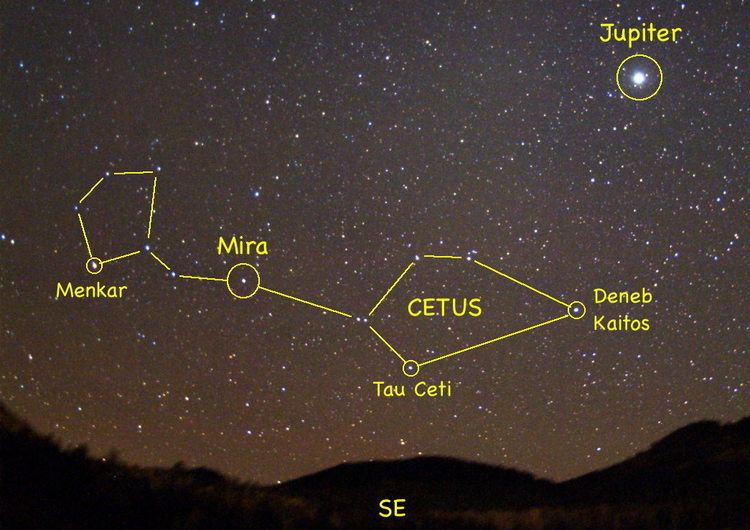 | ||
Mass 1.557 × 10^30 kg (0.783 M☉) Right ascension 01h 44m 04.083s Declination −15° 56′ 14.93″ Evolutionary stage Main sequence Spectral type G8V U−B color index +0.21 B−V color index +0.72 Radial velocity (Rv) −16.68±0.05 km/s Proper motion (μ) RA: −1721.728 mas/yr, Dec.: +854.963 mas/yr Parallax (π) 273.8097 ± 0.1701 mas Distance 11.912 ± 0.007 ly, (3.652 ± 0.002 pc) Absolute magnitude (MV) 5.69±0.01 Absolute bolometric magnitude (Mbol) 5.52±0.02 Mass 0.783±0.012 M Radius 0.793±0.004 R Luminosity 0.488±0.010 L Surface gravity (log g) 4.48±0.05 cgs Metallicity Metallicity [Fe/H] Rotation 34 d, 46±4 d Rotational velocity (v sin i) 0.1±0.1 km/s Age 8–10 Gyr Similar Epsilon Eridani, Epsilon Indi, YZ Ceti | ||
Tau Ceti (τ Cet, τ Ceti) is a star in the constellation Cetus that is spectrally similar to the Sun, although it has only about 78% of the Sun's mass. At a distance of just under 12 light-years (3.7 parsecs) from the Solar System, it is a relatively nearby star, and is the closest solitary G-class star. The star appears stable, with little stellar variation, and is metal-deficient.
Contents
- Name
- Motion
- Physical properties
- Rotation
- Metallicity
- Luminosity and variability
- Sun comparison
- Life and planet searches
- SETI and HabCat
- Planetary system
- Tau Ceti e
- Tau Ceti f
- Debris disk
- References
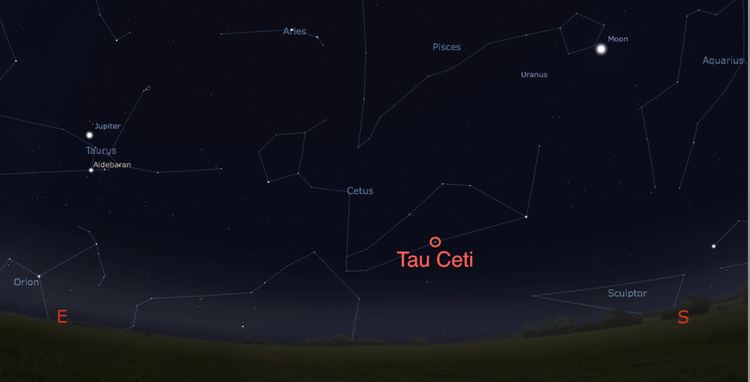
Observations have detected more than ten times as much dust surrounding Tau Ceti as is present in the Solar System. Since December 2012, there has been evidence of possibly five planets orbiting Tau Ceti, with two of these being potentially in the habitable zone. Because of its debris disk, any planet orbiting Tau Ceti would face far more impact events than Earth. Despite this hurdle to habitability, its solar analog (Sun-like) characteristics have led to widespread interest in the star. Given its stability, similarity and relative proximity to the Sun, Tau Ceti is consistently listed as a target for the Search for Extra-Terrestrial Intelligence (SETI), and it appears in some science fiction literature.
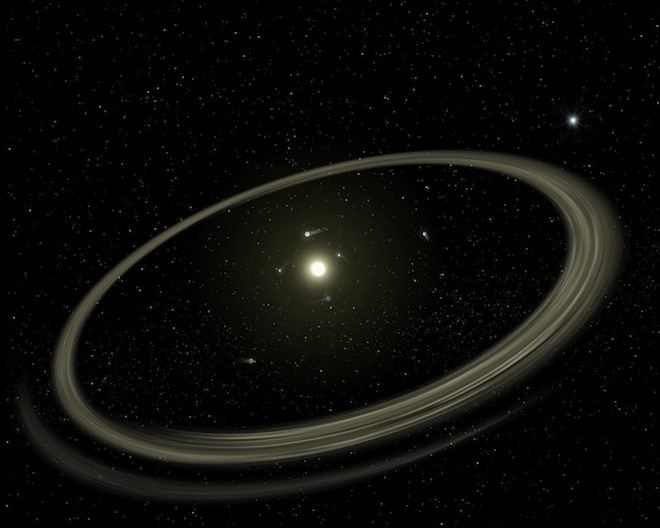
It can be seen with the unaided eye as a third-magnitude star. As seen from Tau Ceti, the Sun would be a third-magnitude star in the northern hemisphere Constellation Boötes.
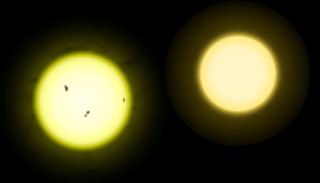
Name
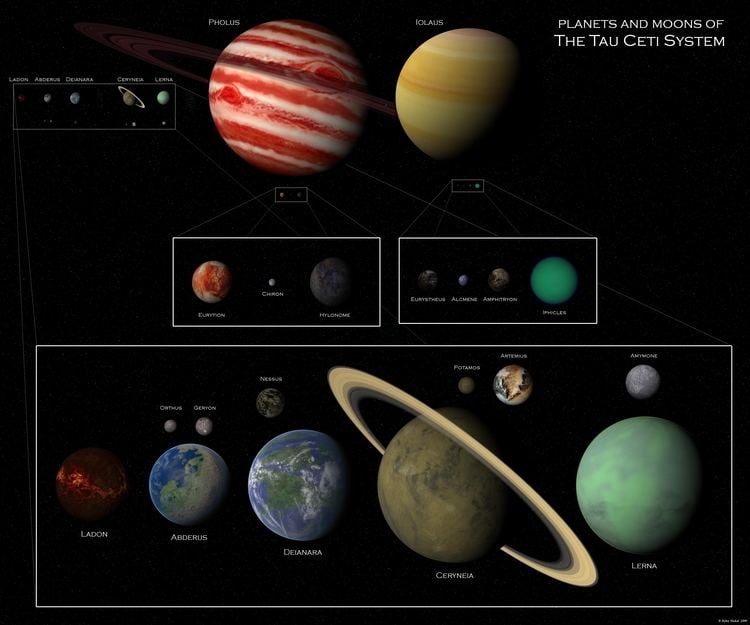
The name "Tau Ceti" is the Bayer designation for this star, established in 1603 as part of German celestial cartographer Johann Bayer's Uranometria star catalogue: it is "number T" in Bayer's sequence of constellation Cetus. In the catalogue of stars in the Calendarium of Al Achsasi al Mouakket, written at Cairo about 1650, this star was designated Thālith al Naʽāmāt (تالت ألنعامة - taalit al naʽāmāt), which was translated into Latin as Tertia Struthionum, meaning the third of the ostriches. This star, along with η Cet (Deneb Algenubi), θ Cet (Thanih Al Naamat), ζ Cet (Baten Kaitos), and υ Cet, were Al Naʽāmāt (ألنعامة), the Hen Ostriches.
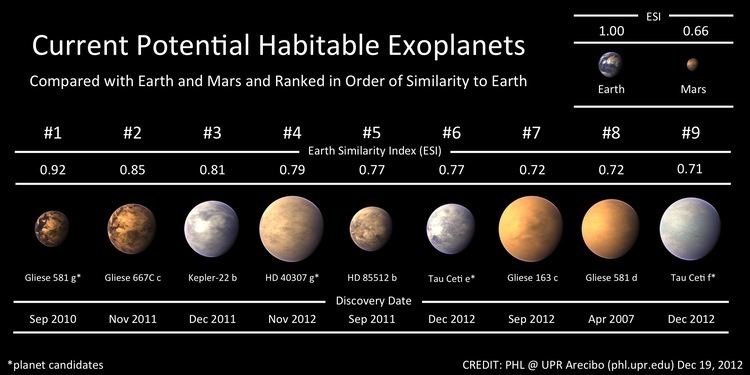
In Chinese, the "Square Celestial Granary" (Chinese: 天倉; pinyin: Tiān Cāng) refers to an asterism consisting of τ Ceti, ι Ceti, η Ceti, ζ Ceti, θ Ceti and 57 Ceti. Consequently, τ Ceti itself is known as the "Fifth Star of Square Celestial Granary" (Chinese: 天倉五; pinyin: Tiān Cāng wǔ).
Motion
The proper motion of a star is its amount of movement across the celestial sphere, determined by comparing its position relative to more distant background objects. Tau Ceti is considered to be a high-proper-motion star, although it only has an annual traverse of just under two arc seconds. It will require about two thousand years before the location of this star shifts by more than a degree. A high Proper motion is an indicator of closeness to the Sun. Nearby stars can traverse an angle of arc across the sky more rapidly than the distant background stars and are good candidates for parallax studies. In the case of Tau Ceti, the Parallax measurements indicate a distance of 7017112582692623711♠11.9 ly. This makes it one of the closest star systems to the Sun, and the next-closest spectral class-G star after Alpha Centauri A.
The radial velocity of a star is its motion toward or away from the Sun. Unlike proper motion, a star's radial velocity cannot be directly observed, but must be determined through measurement of the spectrum. Due to the Doppler shift, the absorption lines in the spectrum of a star will be shifted slightly toward the red (or longer wavelengths) if the star is moving away from the observer, or toward blue (or shorter wavelengths) when it moves toward the observer. In the case of Tau Ceti, the radial velocity is about −17 km/s, with the negative value indicating that it is moving toward the Sun.
The distance to Tau Ceti, along with its proper motion and radial velocity, allow the motion of the star through space to be calculated. The space velocity relative to the Sun is about 7004370000000000000♠37 km/s. This result can then be used to compute an orbital path of Tau Ceti through the Milky Way. It has a mean galacto-centric distance of 7000969999999999999♠9.7 kiloparsec (7020302743375122585♠32000 ly) and an orbital eccentricity of 0.22.
Physical properties
The Tau Ceti system is believed to have only one stellar component. A dim optical companion has also been observed with magnitude 13.1. As of 2000, it was 7002137000000000000♠137 arcseconds distant from the primary. It may be gravitationally bound, but it is considered more likely to be a line-of-sight coincidence.
Most of what is known about the physical properties of Tau Ceti and its system has been determined through spectroscopic measurements. By comparing the spectrum to computed models of stellar evolution, the Age, Mass, Radius and luminosity of Tau Ceti can be estimated. However, using an astronomical interferometer, measurements of the Radius of the star can be made directly to an accuracy of 0.5%. Through such means, the radius of Tau Ceti has been measured to be 79.3 ± 0.4% of the solar radius. This is about the size that is expected for a star with somewhat lower Mass than the Sun.
Rotation
The rotation period for Tau Ceti was measured by periodic variations in the classic H and K absorption lines of singly ionized calcium, or Ca II. These lines are closely associated with surface magnetic activity, so the period of variation measures the time required for the activity sites to complete a full Rotation about the star. By this means the rotation period for Tau Ceti is estimated to be 7006293760000000000♠34 d. Due to the Doppler effect, the rotation rate of a star affects the width of the absorption lines in the spectrum. (Light from the side of the star moving away from the observer will be shifted to a longer wavelength; light from the side moving towards the observer will be shifted toward a shorter wavelength.) By analyzing the width of these lines, the rotational velocity of a star can be estimated. The projected rotation velocity for Tau Ceti is:
veq · sin i ≈ 1 km/swhere veq is the velocity at the equator and i is the inclination angle of the rotation axis to the line of sight. For a typical G8 star, the rotation velocity is about 7003250000000000000♠2.5 km/s. The relatively low rotational velocity measurements may indicate that Tau Ceti is being viewed from nearly the direction of its pole.
Metallicity
The chemical composition of a star provides important clues to its evolutionary history, including the age at which it formed. The interstellar medium of dust and gas from which stars form is primarily composed of hydrogen and helium with trace amounts of heavier elements. As nearby stars continually evolve and die, they seed the interstellar medium with an increasing portion of heavier elements. Thus younger stars will tend to have a higher portion of heavy elements in their atmospheres than do the older stars. These heavy elements are termed metals by astronomers and the portion of heavy elements is the metallicity. The amount of metallicity in a star is given in terms of the ratio of iron (Fe), an easily observed heavy element, to hydrogen. A logarithm of the relative iron abundance is compared to the Sun. In the case of Tau Ceti, the atmospheric metallicity is roughly:
equivalent to about a third the solar abundance. Past measurements have varied from −0.13 to −0.60.
This lower abundance of iron indicates that Tau Ceti is almost certainly older than the Sun. Its age had previously been estimated to be about 7017315576000000000♠10 Ga but is now thought to be around half that at 7017183034080000000♠5.8 Ga. This compares with 7017144218232000000♠4.57 Ga for the Sun. However, computed age estimates for Tau Ceti can range from 4.4–7017378691200000000♠12 Ga, depending on the model adopted.
Besides rotation, another factor that can widen the absorption features in the spectrum of a star is pressure broadening. The presence of nearby particles will affect the radiation emitted by an individual particle. So the line width is dependent on the surface pressure of the star, which in turn is determined by the Temperature and Surface gravity. This technique was used to determine the surface gravity of Tau Ceti. The log g, or logarithm of the star's surface gravity, is about 4.4—very close to the log g = 4.44 for the Sun.
Luminosity and variability
The Luminosity of Tau Ceti is equal to only 55% of the Sun's luminosity. A terrestrial planet would need to orbit this star at a distance of about 7011104718509490000♠0.7 AU in order to match the solar-insolation level of Earth. This is approximately the same as the average distance between Venus and the Sun.
The chromosphere of Tau Ceti—the portion of a star's atmosphere just above the light-emitting photosphere—currently displays little or no magnetic activity, indicating a stable star. One nine-year study of temperature, granulation, and the chromosphere showed no systematic variations; Ca II emissions around the H and K infrared bands show a possible 11-year cycle, but this is weak relative to the Sun. Alternatively it has been suggested that the star could be in a low-activity state analogous to a Maunder minimum—a historical period, associated with the Little Ice Age in Europe, when sunspots became exceedingly rare on the Sun's surface. Spectral line profiles of Tau Ceti are extremely narrow, indicating low turbulence and observed rotation. The amplitude of the star's oscillations are about half those of the Sun, and have a lower mode lifetime.
Sun comparison
This chart compares the Sun to Tau Ceti.
Life and planet searches
Principal factors driving research interest in Tau Ceti are its proximity, Sun-like characteristics and their implications for possible planets and life. For categorization purposes, Hall and Lockwood report that "the terms 'solarlike star', 'solar analog', and 'solar twin' [are] progressively restrictive descriptions". Tau Ceti fits the second category, given its similar Mass and low variability, but relative lack of metals. The similarities have inspired popular culture references for decades, as well as scientific examination.
Tau Ceti has been a target of a radial velocity planetary searches. As of 1988, observations ruled out any periodical variations attributable to massive planets around Tau Ceti inside of Jupiter-like distances. Ever-more precise measurements continue to rule out such planets, at least until December 2012. The velocity precision reached is about 11 m/s measured over a five-year time span. This result excludes the presence of hot Jupiters, and probably excludes any planets with minimum mass greater than or equal to Jupiter's mass and with orbital periods less than 15 years. In addition, a survey of nearby stars by the Hubble Space Telescope's Wide Field and Planetary Camera was completed in 1999, including a search for faint companions to Tau Ceti; none were discovered to limits of the telescope's resolving power.
These searches only excluded larger brown dwarf bodies and giant planets, so smaller, Earth-like planets in orbit around the star were not precluded. If "hot Jupiters" did exist in close orbit they would likely disrupt the star's habitable zone; their exclusion was thus considered positive for the possibility of Earth-like planets. General research has shown a positive correlation between the presence of planets and a relatively high-metallicity parent star, suggesting that stars with lower metallicity such as Tau Ceti have a lower chance of having planets. Primitive life on Tau Ceti's planets might reveal itself through an atmospheric composition unlikely to be abiotic, just as oxygen on Earth is indicative of life.
SETI and HabCat
The most optimistic search project to date was Project Ozma, which was intended to "search for extraterrestrial intelligence" (SETI) by examining selected stars for indications of artificial radio signals. It was run by the astronomer Frank Drake, who selected Tau Ceti and Epsilon Eridani as the initial targets. Both are located near the Solar System and are physically similar to the Sun. No artificial signals were found despite 200 hours of observations. Subsequent radio searches of this star system have also turned up negative.
This lack of results has not dampened interest in observing the Tau Ceti system for biosignatures. In 2002, astronomers Margaret Turnbull and Jill Tarter developed the Catalog of Nearby Habitable Systems (HabCat) under the auspices of Project Phoenix, another SETI endeavour. The list contained more than 7004170000000000000♠17,000 theoretically habitable systems, approximately 10% of the original sample. The next year, Turnbull would further refine the list to the 30 most promising systems out of 7003500000000000000♠5000 within one hundred light-years of the Sun, including Tau Ceti; this will form part of the basis of radio searches with the Allen Telescope Array. She also chose Tau Ceti for a final shortlist of just five stars suitable for searches by the (indefinitely postponed) Terrestrial Planet Finder telescope system, commenting that "these are places I'd want to live if God were to put our planet around another star".
Planetary system
On December 19, 2012, evidence was presented that suggest a system of five planets orbiting Tau Ceti. The planets' estimated minimum masses are between two and six times the mass of Earth and their orbital periods range from 14 to 640 days. One of them, tentatively named Tau Ceti e, appears to orbit about half as far from Tau Ceti as Earth does from the Sun. With Tau Ceti's luminosity of 52% that of the Sun and a distance from the star of 0.552 AU, the planet would receive 1.71 times as much stellar radiation as Earth does, slightly less than Venus with 1.91 times Earth's. Nevertheless, some research places it within the star's habitable zone. The Planetary Habitability Laboratory has estimated that Tau Ceti f, which would receive 28.5% as much starlight as Earth, would be narrowly within the habitable zone of the star as well.
The habitable zone for this star, defined as the locations where liquid water could be present on an Earth-size planet, is at a radius of 0.55–1.16 AU, where 1 AU is the average distance from the Earth to the Sun.
Tau Ceti e
Tau Ceti e is an unconfirmed, fourth-known planet orbiting Tau Ceti that was detected by statistical analyses of the data of the star's variations in radial velocity that were obtained using HIRES, AAPS, and HARPS. Few properties of the planet are known other than its orbit and mass. It orbits at a distance of 0.552 AU (between the orbits of Venus and Mercury in the Solar System) with an Orbital period of 168 days and has a minimum mass of 4.3 Earth masses. Because the minimum mass of a super-Earth is 5 Earth masses, Tau Ceti e may be Earth sized. If it possesses an Earth-like atmosphere, the surface temperature would be around 68 °C (154 °F).
Tau Ceti f
Tau Ceti f is an unconfirmed fifth super Earth planet orbiting Tau Ceti that was discovered in 2012 by statistical analyses of the star's variations in radial velocity, based on data obtained using HIRES, AAPS, and HARPS. It is of interest because its orbit places it in Tau Ceti's extended habitable zone.
Few properties of the planet are known other than its orbit and mass. It orbits Tau Ceti at a distance of 1.35 AU (near Mars's orbit in the Solar System) with an Orbital period of 642 days and has a minimum mass of 6.6 Earth masses, which means it may be a super-Earth.
Debris disk
In 2004, a team of UK astronomers led by Jane Greaves discovered that Tau Ceti has more than ten times the amount of cometary and asteroidal material orbiting it than does the Sun. This was determined by measuring the disk of cold dust orbiting the star produced by collisions between such small bodies. This result puts a damper on the possibility of complex life in the system, because any planets would suffer from large impact events roughly ten times more frequently than Earth. Greaves noted at the time of her research that "it is likely that [any planets] will experience constant bombardment from asteroids of the kind believed to have wiped out the dinosaurs". Such bombardments would inhibit the development of biodiversity between impacts. However, it is possible that a large Jupiter-sized gas giant could deflect comets and asteroids.
The debris disk was discovered by measuring the amount of radiation emitted by the system in the far infrared portion of the spectrum. The disk forms a symmetric feature that is centered on the star, and the outer radius averages 7012822788288850000♠55 AU. The lack of infrared radiation from the warmer parts of the disk near Tau Ceti imply an inner cut-off at a radius of 7012149597870700000♠10 AU. By comparison, the Solar System's Kuiper belt extends from 30–7012747989353500000♠50 AU. To be maintained over a long period of time, this ring of dust must be constantly replenished through collisions by larger bodies. The bulk of the disk appears to be orbiting Tau Ceti at a distance of 35–7012747989353500000♠50 AU, well outside the orbit of the habitable zone. At this distance, the dust belt may be analogous to the Kuiper belt that lies outside the orbit of Neptune in the Solar System.
Tau Ceti's characteristics demonstrate that stars do not necessarily shed large disks as they age, suggesting that the presence of substantial belts may be relatively common among stars similar to the Sun. The debris belt surrounding Tau Ceti is notably less dense, being only 1/20th as dense as that around Epsilon Eridani, a younger neighboring star. The comparative scarcity of debris in our Solar System could be an anomaly; one hypothesis proposed by a researcher is that the Sun might have encountered a close passage with another star early in its history, resulting in the loss of a significant portion of its comets and asteroids. Stars with large debris disks have altered astronomical thinking about planet formation; debris disk stars, where dust is continually generated by collisions, appear to form planets readily.
